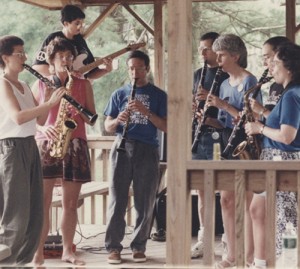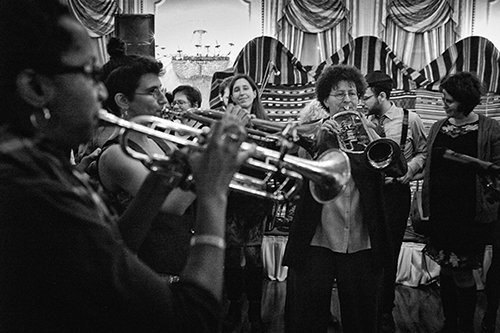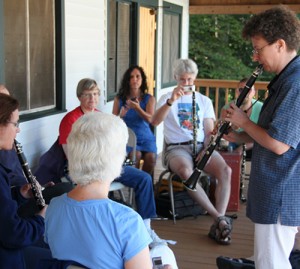Catherine Foster attended her first EEFC Balkan Music & Dance Workshop at Buffalo Gap in the early 1990s and has taught brass band ensemble or clarinet and saxophone at the East Coast workshops numerous times since 1994. But she has been performing Balkan music for more than 30 years. Currently a member of Zlatne Uste Balkan Brass Band and director of the Catherine Foster Brass Band, she has also toured with Yuri Yunakov and worked with Roma brass band musicians in Serbia.
Catherine Foster grew up on Bainbridge Island, near Seattle, Wash., one of five sisters. Their parents, immigrants from New Zealand, played various kinds of music, including early music on recorders. Their mother taught the girls to read music and play basic things on the piano when they were very young.
“I can’t remember not knowing how to read music,” Catherine says. “I’ve always had that.” She also has a good ear, as does everyone else in her family.
Eventually the daughters developed their own musical interests. Catherine’s oldest sister, Susan, sings and for a time played viola with the Seattle Philharmonic. The next oldest, Elizabeth, lives in Australia, where she is working on a doctorate in piano pedagogy. Catherine’s twin, Leslie, lives in Tacoma; she plays Scandinavian fiddle with Hale Bill and the Bopps and composes music. And Mary, the youngest, is a professional piano teacher on Bainbridge Island.
When Catherine and Leslie were going into sixth grade, their mother said, “You can play in the school band. What do you want to play?” Catherine said, “The drums.” Her mother said, “Not in my house.” That was the end of Catherine’s drumming career. Instead, she and Leslie started playing clarinet, but Catherine hated it. She switched to trumpet and played that through middle and high school.
“When we were in high school, somehow Leslie discovered folk dancing and dragged me into it,” Catherine says. “We went to the University of Washington and danced with that group. That was very important in those formative years for us; it gave us a way of surviving high school. I was not a rock concert kid.”
By her late teens, Catherine was dancing two to three nights a week. At a dance camp in Oregon, she and Leslie met Atanas Kolarovski and were surprised to learn that he lived in Seattle and, along with his wife, Ljupka, had a restaurant called Yugoslavia. The restaurant became like a second home for the two girls. Catherine remembers Atanas coming out of a back room into the restaurant with his accordion and playing. Sometimes there would be other musicians as well.
“He was very important to our dancing in those days, and he figured prominently in our developing sense of style,” she says. “He’s a great teacher and has the energy of a lot of people. He would walk into a room on a Friday night where we’d be folk dancing and the energy level would jump up a few notches. It was amazing. You could be three or four people down the line from him and feel his energy through everyone’s hands.”
From Scandinavian Fiddle to Balkan Brass

Catherine with her sisters playing Scandinavian fiddle; left to right: Elizabeth Foster, Catherine Foster and Leslie Foley. (photo courtesy Catherine Foster)
After high school, Scandinavian music came into Catherine’s life. Leslie was working for a man named C. Alan (Bud) Johnson, who had an artwork business on Bainbridge Island. He and his daughter Laurie played Scandinavian fiddles together. Leslie took up the violin and began playing with them, then Elizabeth joined, and finally Catherine. The five named themselves the Rollingbay Fiddlers (after the name of their neighborhood) and started playing for dance parties and festivals. They played almost exclusively Swedish music.
“When I play the violin now, the only thing I can do is Swedish,” Catherine says. “My hands only know that ornamentation.”
In the early ‘80s, Catherine was taking classes at Seattle Central Community College when she heard about a brass-style Balkan band starting up. She called them up, offering herself as a trumpet player, but there wasn’t an opening. Not long afterwards, they called her back and invited her into the group. That was the Borozan Brass Band, which included Peter Lippman on trumpet, Sonia Tamar-Seeman on clarinet, and others.
“That was a great funky brass band,” she says. “That was my beginning playing brass. Peter had been overseas a few times and had tapes from the Guča (Serbia) Festival (Sabor Trubača) and other interesting source material, which we learned by ear.” Even though Catherine is comfortable with sheet music and notates tunes to teach them, she says she can’t learn a piece of music from reading it. “But if I listen to it and play, learning it that way,” she says, “I’ll have it forever.”
In 1986 Peter Lippman moved to New York and Catherine went to work in Alaska on a fish processing barge, a seasonal job she describes as “extremely exhausting and interesting and boring and difficult and wonderful.” At the height of the season, she was one of 100 people living on a 200-foot “shoebox,” with a keen sense of community and camaraderie tempering the hard work.
After returning to Seattle and working at some unmemorable jobs, Catherine moved to New York City in 1988. Peter Lippman had told her about Zlatne Uste. Catherine contacted Michael Ginsburg, the director, and told him she played trumpet and was interested. She was invited into the band.
Going to Guča
Catherine’s first trip to the Guča Festival, in 1990, was Zlatne Uste’s third. It was also her first time in Eastern Europe.
“The level of musicianship across all the bands that came to play and compete at Guča was eye-popping, really amazing,” she says.
Working with a Roma band called Zlatni Prsti, Catherine remembers discovering how much she didn’t know, and how elusive authentic styling was.
“I was struck by how much passion is in the music, and how hard the lives are of the Roma people who struggle to make a life, a living,” she says. “It took away any romantic notions of ‘gypsy’ music. Their lives are really difficult, and they make this fantastic music. Also, I saw the music in its own element, not separated from daily life—music has an important function at a wedding, funeral or war sendoff. It is always played for life events and purposes, not just a recreational party. It was interesting for me to see all of this.”

Playing with Yuri Yunakov's clarinet/sax class, Ramblewood, 1994. (Margaret Loomis)
Around this time, Catherine attended her first EEFC Balkan Music & Dance Workshop. She remembers being struck by the level of community at camp, and by the luxury of having “a whole week of days in a row to spend in my music head without thinking about anything else.”
Working with Yuri Yunakov
In 1994, Yuri Yunakov came to the States from Bulgaria and taught at East Coast Balkan camp. Catherine, who was teaching brass band ensemble that year, wasn’t really aware he was coming, but she had brought a clarinet, which she “didn’t really play.” Because Yuri was there and the schedule was in her favor, she decided to take his clarinet class. It became clear to her almost immediately that she could really understand what Yuri was doing.
After camp, Catherine, who had been attending classes at Hunter College, applied at the college for a scholarship to take private lessons from Yuri. Although she had unsuccessfully applied for a scholarship every previous term she had been there, this time she received a departmental scholarship for private lessons.
She then had to call Yuri and make sure he would be there, wasn’t planning to go back to Bulgaria, and would give her a certain number of lessons and a grade. Not being a Bulgarian speaker, she was nervous as she dialed his phone number. But when his answering machine clicked on and she started talking, someone picked up and a voice said, “Catherine?” It was Carol Silverman; she had been sitting in Yuri’s apartment at the moment Catherine called. Carol helped with communications, Yuri said yes and Catherine began taking lessons.
“It was most amazing,” Catherine says. “A lesson with Yuri meant I would schlep on the train to catch a bus and walk to his apartment, come up to the third floor, he or his wife would make Turkish coffee, there would be some sitting around and smoking cigarettes, then we’d start working and somebody would bang on the door and everything would stop while he greeted the visitor. A lesson would take three hours.” Yuri’s visitors were often shocked to see an American play Bulgarian music and a woman playing clarinet.

Catherine Foster and Yuri Yunakov, Ramblewood, 1995. (Margaret Loomis)
“He is one of the best teachers I’ve ever had and he was very generous with me,” Catherine adds, pointing out that Yuri significantly cut his charges so that Catherine could continue studying with him after the scholarship money ran out.
“He gave me access to how to style this music that I had not had until that point,” she says. “I’ve rarely had the opportunity to work with someone over an extended period like that.”
In 1999, Catherine was invited to participate, along with Yuri, Neshko Neshev on accordion, Salif Ali on drums, Lauren Brody on keyboard and Carol Silverman on vocals, in the World Music Institute’s Gypsy Caravan national tour. The show also included five other ensembles, groups from Russia, Hungary, Romania, Spain and Rajasthan.
“Playing with Yuri was both incredibly amazing and wonderful and at times frustrating and humiliating,” she says. “I was not a musician of that caliber, and it was hard to stand up on stage next to a giant like that and play.”
Leader of the Band
![Catherine and Lefteris Bournias [VERIFY] performing at Balkan camp in the Kavala ensemble.](https://keftimes.org/wp-content/uploads/KT-2014-Winter-Profile-subPhoto5-150x150.jpg)
Catherine and Lefteris Bournias performing at Balkan camp with Kavala. (Margaret Loomis)
Besides performing with Zlatne Uste, Catherine performs with the Kavala Brass Band, made up of some members and alumni of Zlatne Uste and guests, focusing on Greek Macedonian brass repertoire. In that group she plays clarinet except when Lefteris Bournias joins; on those occasions she plays saxophone. Four members of Kavala, including Catherine, play biannually at the Obersteinbach dance camp in Germany, which features Balkan dance primarily.

Catherine Foster Brass Band at Golden Festival, 2014. (Reuben Radding)
And then there’s the all-women Catherine Foster Brass Band, which had its debut at the 2014 Golden Festival and plays mostly South Serbian Romani repertoire. Unlike Zlatne Uste, in which most of the members are older and came out of the folk dance scene, the new ensemble’s members are relatively younger and trained musicians. Starting a band from the ground up is quite different from joining an existing band, or pulling together a band of people who already know and play this music, Catherine notes.
“It’s a lot more work and a different kind of work than being in ZU,” she says. “Being the leader of the band, and having members who aren’t necessarily familiar with this tradition, I need to learn ways to help them. I played the tenor horn at camp this summer to help me better understand that section. I loved feeling that end of the band’s energy. I’m a very melody-driven person—I have melodies in my head all the time—but the vertical structure of the music does not come as naturally to me. I’m looking forward to working with this band as it grows and develops; I see it being a few years before it really gels.
“The all-women aspect of this band is particularly important to me,” she adds. “It’s a serious statement. There are so very few women musicians in the Balkans. There are singers, but hardly any instrumentalists. Sometimes girls play, but as soon as they marry, that’s the end of that. Playing the music of someone else’s culture has always been complicated for me. I try to always be respectful of musical form and culture. I don’t feel I can just shout from the outside that women should be allowed to play instruments. But I can be a model. Among my goals is to play with this band in Serbia and Macedonia and just do what we do and be seen and heard.”
Life in the City
Throughout her years in New York, Catherine has worked at various day jobs, including a brief stint teaching driving in Manhattan and later doing office work for that company. These days she works in the publishing industry for a small company that makes indexes for books. She recently switched from full time to part time there, which is financially difficult but gives her more time for music.
“It’s hard to practice in an apartment,” Catherine says. “I practice in the closet in the back room, and I try not to do it past 9:00 at night. I don’t practice nearly enough, and it’s a big problem finding rehearsal space in New York, although two of my new band’s members have very accommodating households.”
In 2012, Catherine married her longtime partner Ethel Raim, Artistic Director of the Center for Traditional Music and Dance and founder/director of the all-women’s vocal ensemble The Pennywhistlers, one of the first American groups to sing Balkan music. They live in Greenwich Village and occasionally perform singing concerts together.
Teaching at the Workshops

Teaching clarinet on a porch at East Coast camp. (Margaret Loomis)
“I love teaching at Balkan camp,” Catherine says. “Teaching makes me focus in a different way on the music and how I play it and how it happens. I find it very focusing to have to think about ways of teaching, and it’s always interesting because everybody has a different way of learning. I love being a camper and I love being a teacher.”
One challenge she faces at camp, as do the other staff members, is the different levels of students who come to study—a mix of beginning and experienced musicians, amateurs and professionals.
“I love seeing all the young people there,” she says. “Sarah [Ferholt]’s young people’s band is amazing. I find the camps to be wonderful and nurturing places for both younger and older musicians.”



